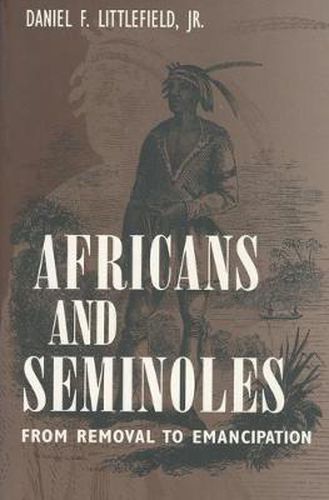Africans and Seminoles: From Removal to Emancipation
Daniel F. Littlefield

Africans and Seminoles: From Removal to Emancipation
Daniel F. Littlefield
This title is printed to order. This book may have been self-published. If so, we cannot guarantee the quality of the content. In the main most books will have gone through the editing process however some may not. We therefore suggest that you be aware of this before ordering this book. If in doubt check either the author or publisher’s details as we are unable to accept any returns unless they are faulty. Please contact us if you have any questions.
Because Seminoles held slaves in a confusing system that was markedly dissimilar to white society’s, the federal government was challenged to identify which blacks in Florida were free and which were not. As claims by slave owners and slave hunters fell into conflict, the Seminoles’ more relaxed form of enslavement threatened the overall institution. This discord was intensified by the Second Seminole War, in which slaves united with Seminoles to fight against the United States. In exchange for capitulation America proffered the coalition unfettered freedom in Indian Territory. In Florida the two societies were so closely linked that, when the government implemented its program of removal, Seminoles and African Americans were transported to Oklahoma together. However, once on their new lands Seminoles and blacks fell into strife with Creeks, who wanted control over both groups, and with Cherokees and Arkansans, who feared an enclave of free blacks near their borders. These disputes drove a wedge between the Seminoles and their black allies. Until the Civil War, blacks were hounded by slave claims that had followed them from the east and by raids of Creeks and white slavers from Arkan-sas. Many blacks were captured and sold. Others fled from Indian Territory and settled in Mexico. At the end of the Civil War free blacks and those of African descent who had remained unemancipated were adopted into the Seminole tribe under provisions of the Treaty of 1866. They began their role in the founding of what today is the modern Seminole Nation of Oklahoma. In a preface to this new edition Littlefield explains the continuing significance of this subject. Daniel F. Littlefield, Jr., a professor of English at the University of Arkansas, Little Rock, and director of American Native Press Archives, is the author of Seminole Burning: A Story of Racial Vengeance and editor, with James W. Parins, of Native American Writing in the Southeast: An Anthology, 1875-1935 (both from University Press of Mississippi).
This item is not currently in-stock. It can be ordered online and is expected to ship in 7-14 days
Our stock data is updated periodically, and availability may change throughout the day for in-demand items. Please call the relevant shop for the most current stock information. Prices are subject to change without notice.
Sign in or become a Readings Member to add this title to a wishlist.


